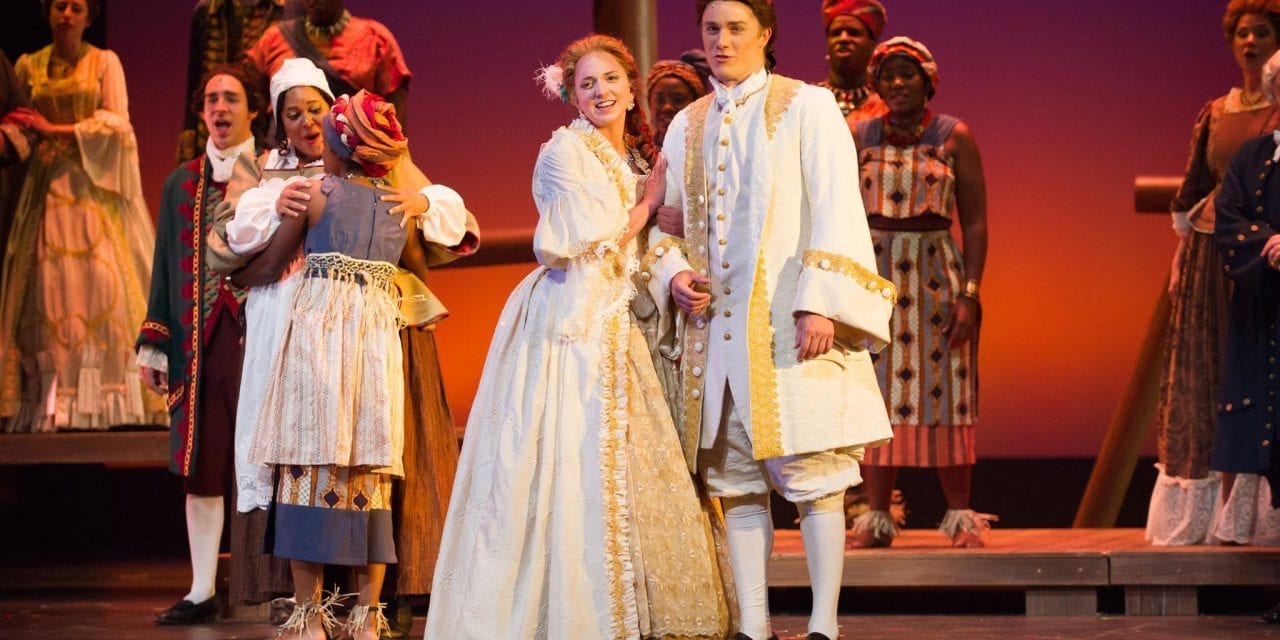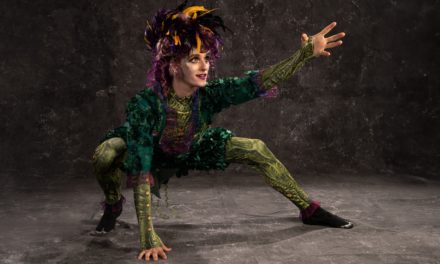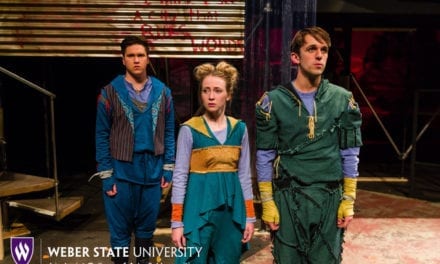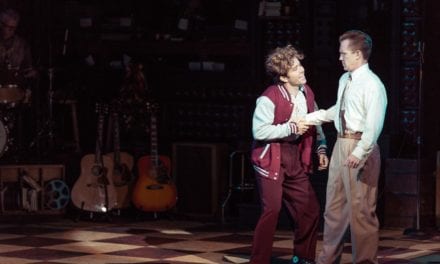LOGAN — This year’s Utah Festival Opera & Musical Theatre had a wonderful opening night with Amazing Grace. The ambiance was fantastic and the music beautiful, and I especially enjoyed the performance of world-renowned opera singer and director of the festival, Michael Ballam.

Amazing Grace (music and lyrics by Christopher Smith, with book by Christopher Smith and Arthur Giron) tells the story of John Newton, the man who composed the familiar hymn of the same name. The plot begins in 1743, when John, after being at sea, returns home, only to be in arguments with his childhood friend and love interest, Mary Catlett, and his father, Captain Newton. When John takes over a slave auction for his father, abolitionists break up the auction and help a slave escape. Mary aids the abolitionists and helps them to spy on Major Gray, who is interested in marrying Mary. Meanwhile, John is detained and forced to serve the British Navy on a ship, his father refusing to help him. His carelessness at sea causes the death of the whole crew, except for him and his slave, Thomas. Both end up in Sierra Leone, captured by Princess Peyai, who has protected herself from becoming a slave by being a slave trader.
Director and choreographer Valerie Rachelle provided a lovely experience. With the stage being so big, she made it easy to see what was going on from one side to the other. During the final scene when everyone sang “Amazing Grace,” I appreciated the blocking of John and Mary moving around the people present in greeting and gratitude, and the joining back together of Nanna and her daughter. I also loved the fight scenes, choreographed by Stefan Espinosa, where the music and lighting followed fast movement and slow motion to see the important moments. One of these was during the first fight with the abolitionists, and the slow motion came when Mary gives her cloak to the slave to save her life, which effectively emphasized that plot twist. I wished in the later fight with Captain Newton and Princess Peyai it had been easier to see who was being shot and when. It seemed that the sound and lighting were off.

The cast of Utah Festival Opera & Musical Theatre’s production of Amazing Grace. Photo by Waldron Creative.
The set, designed by Shawn Fisher, was enormous to fit the huge stage. The intricate carvings on the walls, balcony, and bordering the proscenium were epic. The set consisted of a huge mast and ropes to a ship, with flats of planks that could move up or down to fit the ship set or dock or African buildings. There was another border that looked more like bamboo for the Africa staging. I loved how the lighting, designed by Chris Wood, enhanced the beauty of the set. The sunsets of deep pink and purple looked real and showed a nice contrast to the brown set pieces. The lighting was so bright on the dark stage that I jumped with surprise.
The singing and acting were wonderful. I loved Captain Newton, played by Ballam. He had such a command of the stage that it seemed like the energy coming from him could knock over his fellow actors. The moment when he sang about Captain Newton’s regret at losing his son and the determination to get him back was very moving.
Benjamin Adams played John and was able to match Ballam’s energy onstage for the first song. “Truly Alive” is a very relatable piece about a child wanting to be seen as a unique person and allowed freedom of autonomy from his father. His father just wants the best for him and is determined to force that on him if he doesn’t choose it. When his son breaks off all ties, the father eventually wishes he had been able to have another chance with his child, and the emotional change I saw Ballam go through was poignant.
One of the most moving characters was Thomas, played by Darren Drone. When Drone sang Thomas’s line to John, “No one is leaving here un-judged,” after John betrays him and sells him, it sent shivers up my spine knowing taking someone’s freedom and humanity away is a serious crime. Drone’s voice was deep, rich, and magnificent. I wished his songs lasted longer.
I also felt that way about Nanna, played by Jenina Gallaway. Her character did not get enough time to sing and share her pain. The story of losing her daughter was so touching that I wish there had been a moment of silence at their reunion before the song “Amazing Grace,” which would have set the stage for that song perfectly. As it happened, they reunited during the song and when I felt they would have rushed to each other, they sang a couple of lines before embracing, which took me out of the moment. I wanted to feel their joy and cry, but the poor timing ended what could have been an emotional moment for me.
Olivia Yokers, who played Mary, impressed me with the difficult music she so easily flew through. She was able to sing lightly on the arias and intensely during the emotional songs. Her character was beginning to understand the seriousness of slavery at the beginning of the play. By her final speech to the king, she was the epitome of the anger felt by all whom slavery harmed. I wanted to get up and shout with her, and was annoyed and surprised that the story didn’t have the prince abolish slavery immediately (likely because he did not have the political authority to do so). Princess Peyai, played by Jazmine Olwalia, was an interesting character. Olwalia’s performance excelled by expressing bitterness in everything the princess said to John, and her fear at not knowing as much as the white men. I liked how she moved around the stage with a quick commanding presence.

Left to right: Olivia Yokers as Mary Catlett and Michael Ballam as Captain Newton. Photo by Waldron Creative.
I enjoyed William Remmers’ portrayal of Major Gray. The most vile villain, I came to love this character after he awkwardly spouted poetry to his desired betrothed. Each word came out slowly and oddly, and yet he was so proud of himself afterward despite Mary not feeling moved by his attempt. I laughed as he whined and comically yelled, “Cousin?!” as the prince forced him out of the room by guard.
The set was grand, and the costumes were ever grander. The English ladies wore huge period dresses, innately sewn with ribbons and bows. The African costumes (particularly Princess Peyai’s) were so colorful with tiny designs all over, I just wanted to stare at them the whole show.
The problem with Amazing Grace lies in the writing, specifically the character arc for John. I think the writer tried to show how he came to regret being a slave trader by making him a type of slave, however, his suffering was brief. Once his captor knew he could make her money, she treated him like upper class. At the end he is still upper class, gets married, and yet all the slaves he had sold are mostly stuck where they are. He did so much harm and very little to make up for it. I never reached the point where I forgave him, yet the script tries to make the audience feel that. Mary’s transformation was much more intriguing than John’s, better written, and I wish she had been the main protagonist instead.
There was also the issue of not hearing the perspective of the slaves. For one, they all got less and shorter songs, yet the plot was very focused on them. There was one line that Nanna says about being happy in her village, and I wish there had been some restoration of her and any of the slaves, but there was none. John frees a lot of slaves after his transformation, yet then leaves them to fend for themselves in a land they don’t know, where they’ll probably get captured and sold again. He is an entitled brat at the beginning and becomes a self-righteous entitled love-bird at the end. Finally, (and most importantly), there isn’t a scene for Nanna and her daughter to have some dialogue by the end of the play. I needed that closure; the entire play she talks about missing her daughter, the plot builds up to that moment, and then it is overshadowed by John’s song.
Amazing Grace is worth seeing despite the story flaws. I loved everything about the set, costumes, acting, singing, and tech. The atmosphere is wonderful; during intermission the audience was friendly and the theater had a lovely small-town feel, despite its size and full audience. This festival is a grand one to visit, and you can see new shows all week.
Donate to Utah Theatre Bloggers Association today and help support theatre criticism in Utah. Our staff work hard to be an independent voice in our arts community. Currently, our goal is to pay our reviewers and editors. UTBA is a non-profit organization, and your donation is fully tax deductible.





